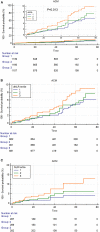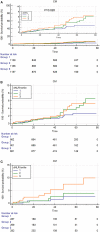Association of Derived Neutrophil-To-Lymphocyte Ratio With Prognosis of Coronary Heart Disease After PCI
- PMID: 34604350
- PMCID: PMC8484317
- DOI: 10.3389/fcvm.2021.705862
Association of Derived Neutrophil-To-Lymphocyte Ratio With Prognosis of Coronary Heart Disease After PCI
Abstract
Aims: The present study aimed to investigate the prognostic role of derived neutrophil-to-lymphocyte ratio (dNLR) in patients with coronary heart disease (CHD) after PCI. Methods: A total of 3,561 post-PCI patients with CHD were retrospectively enrolled in the CORFCHD-ZZ study from January 2013 to December 2017. The patients (3,462) were divided into three groups according to dNLR tertiles: the first tertile (dNLR < 1.36; n = 1,139), second tertile (1.36 ≥ dNLR < 1.96; n = 1,166), and third tertile(dNLR ≥ 1.96; n = 1,157). The mean follow-up time was 37.59 ± 22.24 months. The primary endpoint was defined as mortality (including all-cause death and cardiac death), and the secondary endpoint was major adverse cardiovascular events (MACEs) and major adverse cardiovascular and cerebrovascular events (MACCEs). Results: There were 2,644 patients with acute coronary syndrome (ACS) and 838 patients with chronic coronary syndrome (CCS) in the present study. In the total population, the all-cause mortality (ACM) and cardiac mortality (CM) incidence was significantly higher in the third tertile than in the first tertile [hazard risk (HR) = 1.8 (95% CI: 1.2-2.8), p = 0.006 and HR = 2.1 (95% CI: 1.23-3.8), p = 0.009, respectively]. Multivariate Cox regression analyses suggested that compared with the patients in the first tertile than those in the third tertile, the risk of ACM was increased 1.763 times (HR = 1.763, 95% CI: 1.133-2.743, p = 0.012), and the risk of CM was increased 1.763 times (HR = 1.961, 95% CI: 1.083-3.550, p = 0.026) in the higher dNLR group during the long-term follow-up. In both ACS patients and CCS patients, there were significant differences among the three groups in the incidence of ACM in univariate analysis. We also found that the incidence of CM was significantly different among the three groups in CCS patients in both univariate analysis (HR = 3.541, 95% CI: 1.154-10.863, p = 0.027) and multivariate analysis (HR = 3.136, 95% CI: 1.015-9.690, p = 0.047). Conclusion: The present study suggested that dNLR is an independent and novel predictor of mortality in CHD patients who underwent PCI.
Keywords: coronary heart disease; derived neutrophil-to-lymphocyte ratio; mortality; neutrophil-to-lymphocyte ratio; percutaneous coronary intervention.
Copyright © 2021 Liu, Zhang, Shangguan, Zhu, Wang, Guo, Zhang, Wang, Liu, Song, Fan, Zheng and Zhang.
Conflict of interest statement
The authors declare that the research was conducted in the absence of any commercial or financial relationships that could be construed as a potential conflict of interest.
Figures



Similar articles
-
Prognostic Nutritional Index as a Novel Predictor of Long-Term Prognosis in Patients with Coronary Artery Disease After Percutaneous Coronary Intervention.Clin Appl Thromb Hemost. 2022 Jan-Dec;28:10760296221103271. doi: 10.1177/10760296221103271. Clin Appl Thromb Hemost. 2022. PMID: 36001005 Free PMC article.
-
ALB-dNLR Score Predicts Mortality in Coronary Artery Disease Patients After Percutaneous Coronary Intervention.Front Cardiovasc Med. 2022 Mar 15;9:709868. doi: 10.3389/fcvm.2022.709868. eCollection 2022. Front Cardiovasc Med. 2022. PMID: 35369313 Free PMC article.
-
Predictive Value of Gensini Score in the Long-Term Outcomes of Patients With Coronary Artery Disease Who Underwent PCI.Front Cardiovasc Med. 2022 Jan 24;8:778615. doi: 10.3389/fcvm.2021.778615. eCollection 2021. Front Cardiovasc Med. 2022. PMID: 35141291 Free PMC article.
-
Predictive value of neutrophil to lymphocyte ratio in patients with acute ST segment elevation myocardial infarction after percutaneous coronary intervention: a meta-analysis.BMC Cardiovasc Disord. 2018 May 2;18(1):75. doi: 10.1186/s12872-018-0812-6. BMC Cardiovasc Disord. 2018. PMID: 29716535 Free PMC article. Review.
-
Clinical outcomes with percutaneous coronary revascularization vs coronary artery bypass grafting surgery in patients with unprotected left main coronary artery disease: A meta-analysis of 6 randomized trials and 4,686 patients.Am Heart J. 2017 Aug;190:54-63. doi: 10.1016/j.ahj.2017.05.005. Epub 2017 May 18. Am Heart J. 2017. PMID: 28760214 Review.
Cited by
-
Association between inflammatory burden index and prognosis in patients with coronary heart disease: A retrospective study.PLoS One. 2025 Jul 7;20(7):e0325287. doi: 10.1371/journal.pone.0325287. eCollection 2025. PLoS One. 2025. PMID: 40622923 Free PMC article.
-
Impact of lactate dehydrogenase on prognosis of patients undergoing cardiac surgery.BMC Cardiovasc Disord. 2022 Sep 10;22(1):404. doi: 10.1186/s12872-022-02848-7. BMC Cardiovasc Disord. 2022. PMID: 36088306 Free PMC article.
-
Day 3 neutrophil-to-lymphocyte ratio and its derived indices predict 90-day poor outcomes following mechanical thrombectomy in acute ischemic stroke patients.Front Neurol. 2024 Dec 18;15:1496628. doi: 10.3389/fneur.2024.1496628. eCollection 2024. Front Neurol. 2024. PMID: 39744114 Free PMC article.
-
Association of the derived neutrophil-to-lymphocyte ratio with cardiovascular and all-cause mortality.PLoS One. 2025 Jun 5;20(6):e0324849. doi: 10.1371/journal.pone.0324849. eCollection 2025. PLoS One. 2025. PMID: 40472001 Free PMC article.
-
Predictive role of neutrophil-to-lymphocyte ratio in metabolic syndrome: Meta-analysis of 70,937 individuals.BMC Endocr Disord. 2024 Aug 20;24(1):155. doi: 10.1186/s12902-024-01689-z. BMC Endocr Disord. 2024. PMID: 39164679 Free PMC article.
References
LinkOut - more resources
Full Text Sources
Miscellaneous

